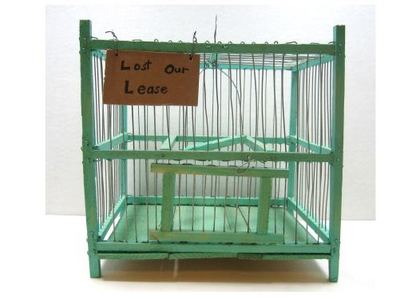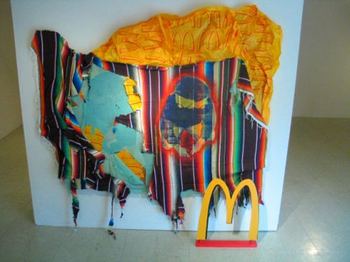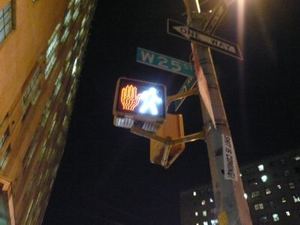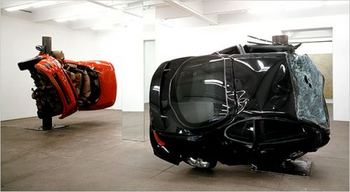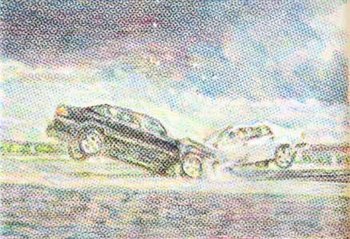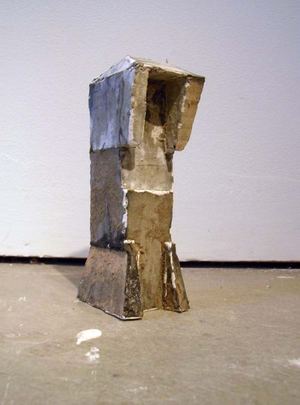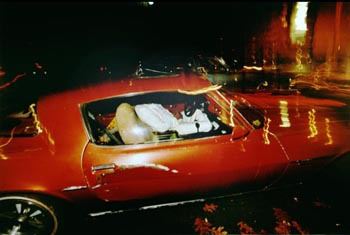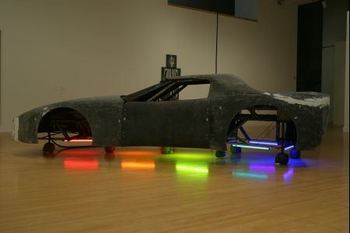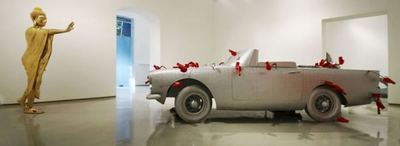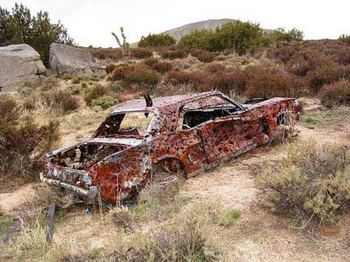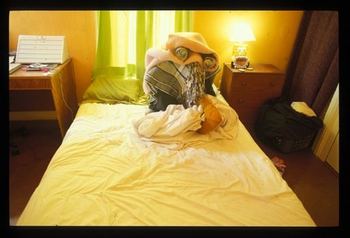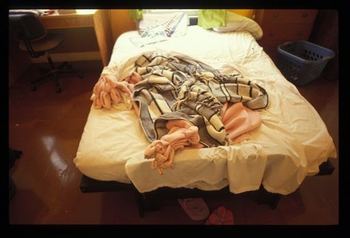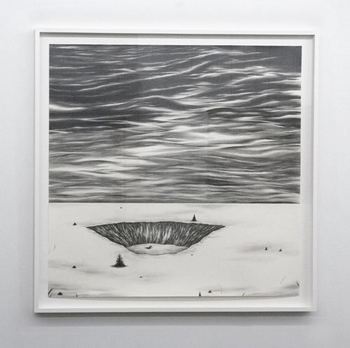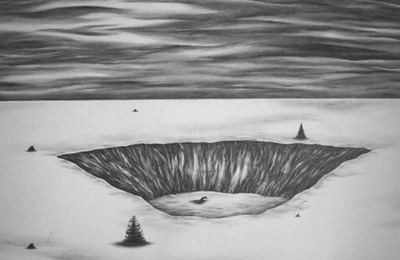MacDonalds appropriated – the rise of Mexican culture in the U.S.
From Manuel Fernando Rios:
From NEWSgrist – street sign
J. G. Ballard (20th century unfolds in 21st) art of the car (crash)
Car consciousness took deepest root on the West Coast, where most of the artists who address it as subject matter have lived. In my version of this art history, everything began with Ed Kienholtz – Back Seat Dodge ’38, 1964, at the Los Angeles County Museum of Art.
Before I was 18, this piece was a news story, thanks to its chicken-wire figures having no-rent oral sex. Get a room? Cars are cheaper. To see it, you had to be 18 or an art history student. Being neither, I didn’t qualify but remember thinking, any art the police don’t want you to see has to be worth seeing. It was the point that I began a switch from a primary interest in literature to a primary one in art.
(Click to enlarge images.)
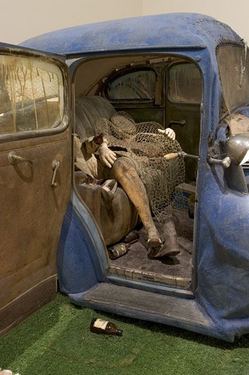 By the early 1970s, J. G. Ballard had begun to think cars as a kind of death-in-life, the equivalent of the cursed ship in The Rime of the Ancient Mariner.
By the early 1970s, J. G. Ballard had begun to think cars as a kind of death-in-life, the equivalent of the cursed ship in The Rime of the Ancient Mariner.
(From Testpattern)
Approximately 2 years before the publication of J.G. Ballard’s novel
CRASH! in 1973, filmmaker Harely Cokliss created his short film
“Towards Crash!” for the BBC which featured two parts: one based on
Ballard’s short story “The Atrocity Exhibition”; the other based on
Ballard’s then short story “Crash!”. He cast Ballard himself as both
narrator and lead alongside B-movie actress Gabrielle Drake. The short
captures a more empirical tone as it studies the binary systems of
structure and force, form and desire, the collisions of bodies as the
tools of a modern empire. The visual style seems almost stark compared
to David Cronenberg’s visual imagining of the material in his 1996
full-length feature CRASH, which dwelled more on the mutative synthesis
of man and machine/technology/society at the end of the (previous) century.
I’m
interested in the automobile as a narrative structure, as a scenario
that describes our real lives and our real fantasies. If every member
of the human race were to vanish overnight, I think it would be
possible to reconstitute almost every element of human psychology from
the design of a vehicle like this.
(Photo, New York Times. Dirk Skreber at Friedrich Petzel Gallery through June 27. Review, Ken Johnson: consumerist desire on a collision course with death (To read review, click through from here.)
As
a writer I feel I must try to understand the real meaning of a lot of
commonplace but tremendously complicated events. I’ve always been
fascinated by the complexity of movement when a woman gets out of a
car. Take a structure like a multi-story car park, one of the most
mysterious buildings ever built. Is it a model for some strange
psychological state, some kind of vision glimpsed within its bizarre
geometry?
Jonathan Schipper at Boiler through June 28.
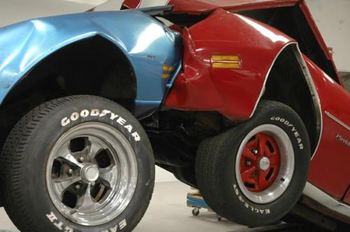 Stephen Andrews, car crash, 2006, crayon rubbing on mylar, from Platform
Stephen Andrews, car crash, 2006, crayon rubbing on mylar, from Platform
What
effect does using these (multi-story car parks) have on us? Are the
real myths of this century being written in terms of these huge
unnoticed structures?
Whiting Tennis, untitled model at Greg Kucera
More
exactly, I think that new emotions and new feelings are being created,
that modern technology is beginning to reach into our dreams and change
our whole way of looking at things, and perceiving reality, that more
and more it is drawing us away from contemplating ourselves to
contemplating its world.
Justin Colt Beckman – road hard and hung up muddy.
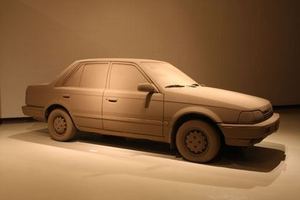 Alice Wheeler, What Women See At Night
Alice Wheeler, What Women See At Night
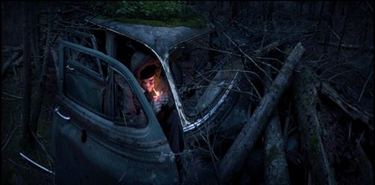 Matthew Day Jackson from The Violet Hour at the Henry, title after Beuys: I Like America and America Likes Me. His muscle car rides on skulls, an allusion to fossil fuel but lit with neon powered by solar panels on the roof. Jackson’s in New York but raised in the Northwest and Northwest in his bones.
Matthew Day Jackson from The Violet Hour at the Henry, title after Beuys: I Like America and America Likes Me. His muscle car rides on skulls, an allusion to fossil fuel but lit with neon powered by solar panels on the roof. Jackson’s in New York but raised in the Northwest and Northwest in his bones.
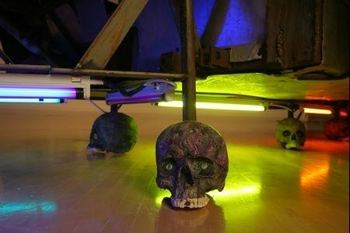
Hugo Ludeña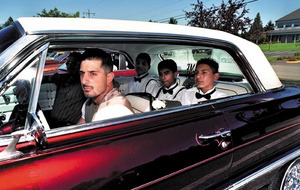 Evah Fan, Hiccup
Evah Fan, Hiccup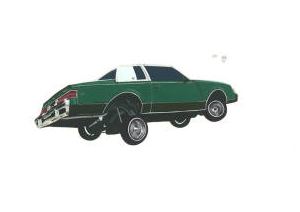 Buddy Bunting
Buddy Bunting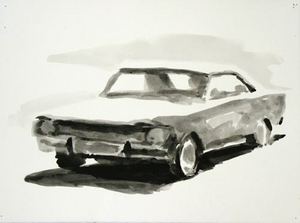
Valay Shende – Buddha Right, Marx Wrong
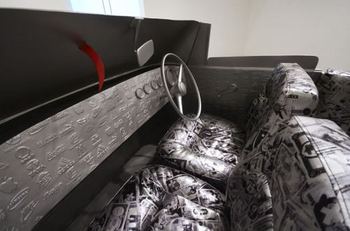
Lee Bul, karaoke machine from Live Forever at the Henry Gallery:
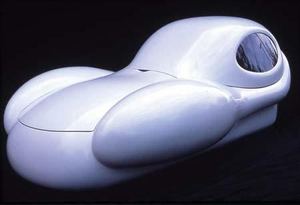 Kathleen Henderson, Pickpocket:
Kathleen Henderson, Pickpocket:
 Gonzalo Lebrija, Entre la vida y la muerte (blanco y negro), from Culture Monster:
Gonzalo Lebrija, Entre la vida y la muerte (blanco y negro), from Culture Monster:
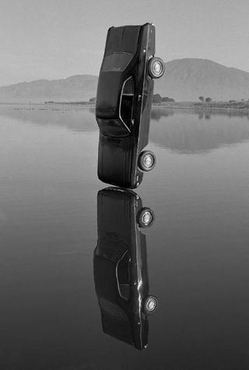
Kenneth Baker, SF Chronicle, What is American art, a car perhaps?
Charles
Linder appears to think continually about the zero degree of art and
how to meander just this side of it. But a second question preoccupies
Linder: What makes American art American?At the center of his Gallery 16 show, facing “Take Me to the
Drive-In,” sits “Ghostang” (2006), a bullet-riddled 1965 Ford Mustang
body that Linder retrieved from the desert and powder-coated to
preserve it and revive it as an ambivalent object of nostalgia for auto
and gun fetishists.
As a monument, it
offers us symbolically the vanity of the gunslinger nation, in tatters.
“Ghostang” will remind some viewers of the radiant ’64 Chevy Malibu
that levitates at the end of “Repo Man.”
But it makes me think also of “The Master Chassis” (1969), the
legendary dragonfly-sleek car-as-sculpture built by former Berkeley
artist Don Potts. Both Potts’ vehicle and Linder’s might serve as
markers on a distinctly American cultural timeline.
(Shown here as he found it.)
Burn this – your face, your body
Isn’t there suddenly a lot of this going on?
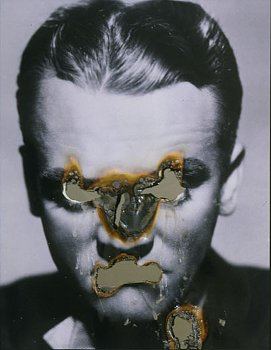 Tomoo Gokita from Ambach & Rice through Saturday.
Tomoo Gokita from Ambach & Rice through Saturday.
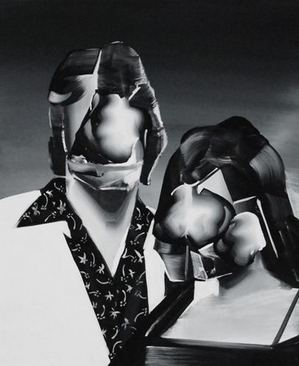 Sara Greenberger Rafferty at Ambach & Rice through Saturday.
Sara Greenberger Rafferty at Ambach & Rice through Saturday.
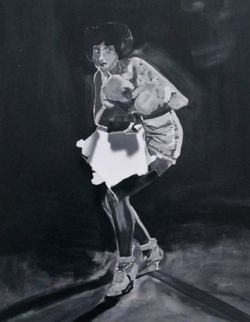 Gordon’s is the most corrosive. Gokita, using models from Japan’s Elvis cult dancers, gives their undoing a jaunty spin. And Rafferty’s is a never-say-die image. Her model has taken a big hit, but she’s still standing and ready to give back.
Gordon’s is the most corrosive. Gokita, using models from Japan’s Elvis cult dancers, gives their undoing a jaunty spin. And Rafferty’s is a never-say-die image. Her model has taken a big hit, but she’s still standing and ready to give back.
Not so new, after all, the anguish, passion and death of the flesh.
Now therefore, while the youthful hue
Sits on thy skin like morning dew,
And while thy willing soul transpires
At every pore with instant fires,
Now let us sport us while we may;
And now, like am’rous birds of prey,
Rather at once our time devour,
Than languish in his slow-chapp’d power.
Let us roll all our strength, and all
Our sweetness, up into one ball;
And tear our pleasures with rough strife
Thorough the iron gates of life.
Thus, though we cannot make our sun
Stand still, yet we will make him run.
from To His Coy Mistress by Andrew Marvel
Larry Sommers – in his honor
He’s the glue that held the University of Washington’s print department together. Obit here. Tribute Facebook page here. Info about Sommers fellowship fund here.
Saturday 11 a.m.-4 p.m.at the Tashiro Kaplan Bullding (310 S. Washington St., Seattle) is a print sale to benefit that fund. I have no information on who’s in the show, but Sommers attracted a great crew. All prints by Sommers. (Item via Brian Lane.)
Brian Dick – art is an unmade bed
From the artist’s Web site:
For many years I’ve been making my bed differently everyday. In this way I am able to combine my work life as an artist with my daily chores. It also gives me an opportunity to work with the same materials over time -changing them again and again, and seeing how many different ways I can remake them sculpturally as well as conceptually.
Bad Reporter – denying gay rights an endless loop
Don Asmussen, Bad Reporter from SF Chronicle via Rooney O’Neil.

Whiting Tennis – the vulnerable intensity of his form
Nothing illustrates the vast plurality of contemporary art more than the fact that these two medicine cabinets exist at the same time.
Damien Hirst:  Whiting Tennis (Link to artist talking):
Whiting Tennis (Link to artist talking):
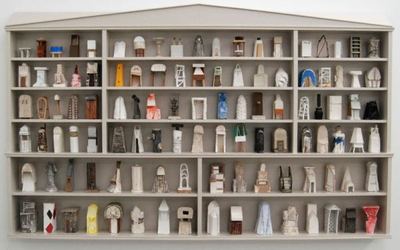
Detail: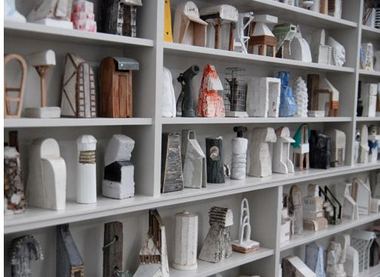
Hirst is cool, Tennis feverish. Hirst’s form is armored, Tennis’ vulnerable. Tennis’ assemblage of his models for sculptures isn’t intended a medicine chest, which is where the comparison breaks down. His elegant gray box is more like a church. Like Robyn O’Neil’s (here), his overal effect is silent, engaging a private implosion.
I value both Hirst and Tennis, but if I could pick one of these objects to live with, it would be Tennis’ a thousand times over, price points be damned.
Tennis is in Supramundane at Ambach & Rice through the weekend. He’s also in Dimension Invention at the Kirkland Arts Center through June 3, which I’m going to see later today. He is represented in Seattle by Greg Kucera .In flusher days, now demised, Kucera would never have let him appear at another local gallery, especially with his best work to date.
Robyn O’Neil – Coming to you from the Middle Ages
Robyn O’Neil’s graphite drawings open a pit under your feet and fail to comfort as you fall. Her version of hell is silence. It’s as frightening as any gargoyle leering at the medieval faithful as they entered their Gothic church.
Abandon all reason, you who enter here. (Click to enlarge; more images at Tony Wright.)



